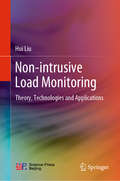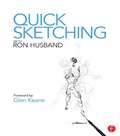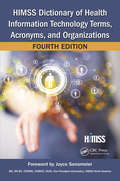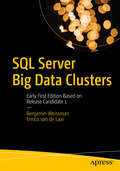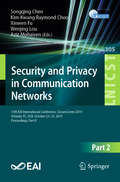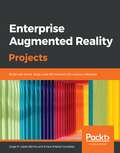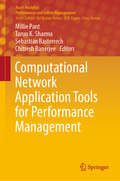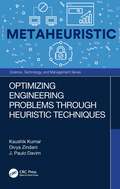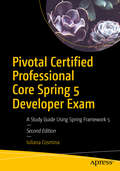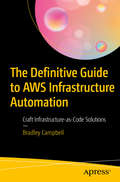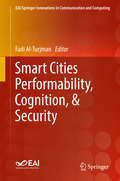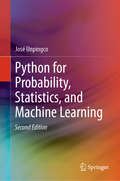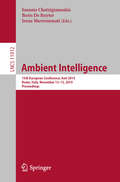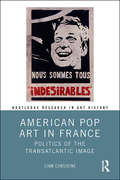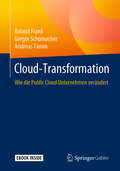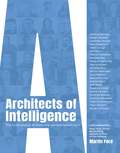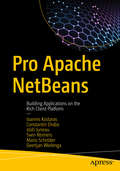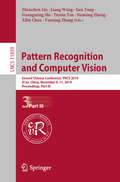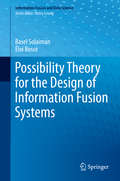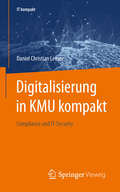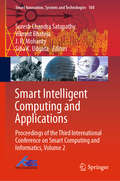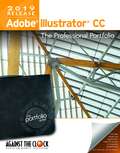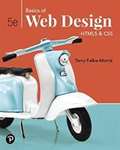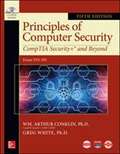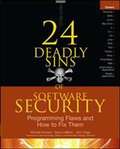- Table View
- List View
Non-intrusive Load Monitoring: Theory, Technologies and Applications
by Hui LiuFocusing on non-intrusive load monitoring techniques in the area of smart grids and smart buildings, this book presents a thorough introduction to related basic principles, while also proposing improvements. As the basis of demand-side energy management, the non-intrusive load monitoring techniques are highly promising in terms of their energy-saving and carbon emission reduction potential.The book is structured clearly and written concisely. It introduces each aspect of these techniques with a number of examples, helping readers to understand and use the corresponding results. It provides latest strengths on the non-intrusive load monitoring techniques for engineers and managers of relevant departments. It also offers extensive information and a source of inspiration for researchers and students, while outlining future research directions.
Quick Sketching with Ron Husband: Revised And Expanded
by Ron HusbandQuick sketching is the best technique you can use to stay finely tuned and to keep those creative juices flowing. To keep your sense of observation heightened, and to sharpen your hand-eye coordination, an animator needs to constantly draw and sketch. Quick Sketching with Ron Husband offers instruction to quick sketching and all its techniques. From observing positive and negative space and learning to recognize simple shapes in complex forms to action analysis and using line of action, this Disney legend teaches you how to sketch using all these components, and how to do it in a matter of seconds. On top of instruction and advice, you’ll also see Ron’s portfolio of select art representing his growth as an artist throughout the years. Watch his drawings as he grows from a young, talented artist, to a true Disney animator. Follow him as he goes around the world and sketches flamenco dancers, football players, bakers, joggers, lions, tigers, anyone, and anything. As if instruction and inspiration in one place weren’t enough, you’ll find a sketchbook included, so you can flip from Ron’s techniques and work on perfecting basic shapes. Or take your book on the road, read Ron’s advice, sketch away, capture the world around you.
HIMSS Dictionary of Health Information Technology Terms, Acronyms, and Organizations (HIMSS Book Series)
by HimssThis significantly expanded and newest edition of the bestselling HIMSS Dictionary of Health Information Technology Terms, Acronyms, and Organizations has been developed and extensively reviewed by more than 50 industry experts. The fourth edition of this dictionary serves as a quick reference for students, health information technology professionals and healthcare executives to better navigate the ever-growing health IT field. This valuable resource includes more than 3000 definitions, 30 new organizations and 76 new references. Definitions of terms for the information technology and clinical, medical and nursing informatics fields are updated and included. This fourth edition also includes an acronyms list with cross references to current definitions, new word-search capability, and a list of health IT-related associations and organizations, including contact information, mission statements and web addresses. Academic and certification credentials are also included. HIMSS North America, a business unit within HIMSS, positively transforms health and healthcare through the best use of information technology in the United States and Canada. As a cause-based non-profit, HIMSS North America provides thought leadership, community building, professional development, public policy, and events. HIMSS North America represents 64,000 individual members, 640 corporate members, and over 450 non-profit organizations. Thousands of volunteers work with HIMSS to improve the quality, cost-effectiveness, access, and value of healthcare through IT. HIMSS Vision Better health through information technology. HIMSS Mission Globally, lead endeavors optimizing health engagements and care outcomes through information technology.
SQL Server Big Data Clusters: Early First Edition Based on Release Candidate 1
by Benjamin Weissman Enrico van de LaarGet a head-start on learning one of SQL Server 2019’s latest and most impactful features—Big Data Clusters—that combines large volumes of non-relational data for analysis along with data stored relationally inside a SQL Server database. This book provides a first look at Big Data Clusters based upon SQL Server 2019 Release Candidate 1. Start now and get a jump on your competition in learning this important new feature. Big Data Clusters is a feature set covering data virtualization, distributed computing, and relational databases and provides a complete AI platform across the entire cluster environment. This book shows you how to deploy, manage, and use Big Data Clusters. For example, you will learn how to combine data stored on the HDFS file system together with data stored inside the SQL Server instances that make up the Big Data Cluster. Filled with clear examples and use cases, this book provides everything necessary to get started working with Big Data Clusters in SQL Server 2019 using Release Candidate 1. You will learn about the architectural foundations that are made up from Kubernetes, Spark, HDFS, and SQL Server on Linux. You then are shown how to configure and deploy Big Data Clusters in on-premises environments or in the cloud. Next, you are taught about querying. You will learn to write queries in Transact-SQL—taking advantage of skills you have honed for years—and with those queries you will be able to examine and analyze data from a wide variety of sources such as Apache Spark. Through the theoretical foundation provided in this book and easy-to-follow example scripts and notebooks, you will be ready to use and unveil the full potential of SQL Server 2019: combining different types of data spread across widely disparate sources into a single view that is useful for business intelligence and machine learning analysis. What You Will LearnInstall, manage, and troubleshoot Big Data Clusters in cloud or on-premise environmentsAnalyze large volumes of data directly from SQL Server and/or Apache SparkManage data stored in HDFS from SQL Server as if it were relational dataImplement advanced analytics solutions through machine learning and AIExpose different data sources as a single logical source using data virtualizationWho This Book Is ForFor data engineers, data scientists, data architects, and database administrators who want to employ data virtualization and big data analytics in their environment
Security and Privacy in Communication Networks: 15th EAI International Conference, SecureComm 2019, Orlando, FL, USA, October 23–25, 2019, Proceedings, Part II (Lecture Notes of the Institute for Computer Sciences, Social Informatics and Telecommunications Engineering #305)
by Wenjing Lou Kim-Kwang Raymond Choo Songqing Chen Xinwen Fu Aziz MohaisenThis two-volume set LNICST 304-305 constitutes the post-conference proceedings of the 15thInternational Conference on Security and Privacy in Communication Networks, SecureComm 2019, held in Orlando, FL, USA, in October 2019. The 38 full and 18 short papers were carefully reviewed and selected from 149 submissions. The papers are organized in topical sections on blockchains, internet of things, machine learning, everything traffic security communicating covertly, let’s talk privacy, deep analysis, systematic theory, bulletproof defenses, blockchains and IoT, security and analytics, machine learning, private, better clouds, ATCS workshop.
Enterprise Augmented Reality Projects: Build real-world, large-scale AR solutions for various industries
by Jorge R. Benito Enara Artetxe GonzalezDesign end-to-end AR solutions for domains such as marketing, retail, manufacturing, tourism, automation, and training Key Features Use leading AR development frameworks such as ARCore, ARKit, and Vuforia across key industries Identify the market potential of AR for designing visual solutions in different business sectors Build multi-platform AR projects for various platforms such as Unity, iOS, and Android Book Description Augmented reality (AR) is expanding its scope from just being used in mobile and game applications to enterprise. Different industries are using AR to enhance assembly line visualization, guide operators performing difficult tasks, attract more customers, and even improve training techniques. In this book, you'll gain comprehensive insights into different aspects of developing AR-based apps for six different enterprise sectors, focusing on market needs and choosing the most suitable tool in each case. You'll delve into the basics of Unity and get familiar with Unity assets, materials, and resources, which will help you build a strong foundation for working on the different AR projects covered in the book. You'll build real-world projects for various industries such as marketing, retail, and automation in a step-by-step manner. This will give you hands-on experience in developing your own industrial AR apps. While building the projects, you'll explore various AR frameworks used in the enterprise environment such as Vuforia, EasyAR, ARCore, and ARKit, and understand how they can be used by themselves or integrated into the Unity 3D engine to create AR markers, 3D models, and components of an AR app. By the end of this book, you'll be well versed in using different commercial AR frameworks as well as Unity for building robust AR projects. What you will learn Understand the basics of Unity application development and C# scripting Learn how to use Android Studio along with ARCore and Sceneform to build AR prototypes for Android devices Enable AR experiences on the web with ARCore and WebAR Explore emerging AR authoring tools such as Augmented Class! for education Understand the differences and similarities between handheld and head-mounted display (HMD) environments and how to build an app for each target Become well versed in using Xcode with ARKit and SceneKit to develop AR portals for iOS devices Who this book is for This book is for anyone interested in emerging and interactive technologies or looking to build AR applications for any domain. Although, no prior augmented reality experience is required, having some skills in object-oriented programming (OOP) will be helpful.
Computational Network Application Tools for Performance Management (Asset Analytics)
by Millie Pant Tarun K. Sharma Sebastián Basterrech Chitresh BanerjeeThis book explores a range of important theoretical and practical issues in the field of computational network application tools, while also presenting the latest advances and innovations using intelligent technology approaches. The main focus is on detecting and diagnosing complex application performance problems so that an optimal and expected level of system service can be attained and maintained. The book discusses challenging issues like enhancing system efficiency, performance, and assurance management, and blends the concept of system modeling and optimization techniques with soft computing, neural network, and sensor network approaches. In addition, it presents certain metrics and measurements that can be translated into business value. These metrics and measurements can also help to establish an empirical performance baseline for various applications, which can be used to identify changes in system performance. By presenting various intelligent technologies, the book provides readers with compact but insightful information on several broad and rapidly growing areas in the computation network application domain.The book’s twenty-two chapters examine and address current and future research topics in areas like neural networks, soft computing, nature-inspired computing, fuzzy logic and evolutionary computation, machine learning, smart security, and wireless networking, and cover a wide range of applications from pattern recognition and system modeling, to intelligent control problems and biomedical applications. The book was written to serve a broad readership, including engineers, computer scientists, management professionals, and mathematicians interested in studying tools and techniques for computational intelligence and applications for performance analysis. Featuring theoretical concepts and best practices in computational network applications, it will also be helpful for researchers, graduate and undergraduate students with an interest in the fields of soft computing, neural networks, machine learning, sensor networks, smart security, etc.
Optimizing Engineering Problems through Heuristic Techniques (Science, Technology, and Management)
by J. Paulo Davim Kaushik Kumar Divya ZindaniThis book will cover heuristic optimization techniques and applications in engineering problems. The book will be divided into three sections that will provide coverage of the techniques, which can be employed by engineers, researchers, and manufacturing industries, to improve their productivity with the sole motive of socio-economic development. This will be the first book in the category of heuristic techniques with relevance to engineering problems and achieving optimal solutions. Features Explains the concept of optimization and the relevance of using heuristic techniques for optimal solutions in engineering problems Illustrates the various heuristics techniques Describes evolutionary heuristic techniques like genetic algorithm and particle swarm optimization Contains natural based techniques like ant colony optimization, bee algorithm, firefly optimization, and cuckoo search Offers sample problems and their optimization, using various heuristic techniques
Pivotal Certified Professional Core Spring 5 Developer Exam: A Study Guide Using Spring Framework 5
by Iuliana CosminaPass the Pivotal Certified Professional exam for Core Spring, based on the latest Spring Framework 5, using source code examples, study summaries, and mock exams. This book now includes WebFlux, reactive programming, and more found in Spring 5. You'll find a descriptive overview of certification-related Spring modules and a single example application demonstrating the use of all required Spring modules. Furthermore, in Pivotal Certified Professional Core Spring 5 Developer Exam, Second Edition, each chapter contains a brief study summary and question set, and the book’s free downloadable source code package includes one mock exam (50 questions – like a real exam). After using this study guide, you will be ready to take and pass the Pivotal Certified Professional exam.When you become Pivotal Certified, you will have one of the most valuable credentials in Java. Pivotal certification helps you advance your skills and your career, and get the maximum benefit from Spring. Passing the exam demonstrates your understanding of Spring and validates your familiarity with: container-basics, aspect oriented programming (AOP), data access and transactions, Spring Security, Spring Boot, microservices, and Spring model-view-controller (MVC). Good luck!What You Will LearnUnderstand the core principles of Spring Framework 5Use dependency injectionWork with aspects in Spring and do AOP (aspect oriented programming)Control transactional behavior and work with SQL and NoSQL databasesCreate and secure web applications based on Spring MVCGet to know the format of the exam and the type of questions in itCreate Spring microservices applicationsWho This Book Is ForSpring developers who have taken the Pivotal Core Spring class are eligible to take the Pivotal Certified Professional exam.
The Definitive Guide to AWS Infrastructure Automation: Craft Infrastructure-as-Code Solutions
by Bradley CampbellDiscover the pillars of AWS infrastructure automation, starting with API-driven infrastructure concepts and its immediate benefits such as increased agility, automation of the infrastructure life cycle, and flexibility in experimenting with new architectures. With this base established, the book discusses infrastructure-as-code concepts in a general form, establishing principled outcomes such as security and reproducibility. Inescapably, we delve into how these concepts enable and underpin the DevOps movement. The Definitive Guide to AWS Infrastructure Automation begins by discussing services and tools that enable infrastructure-as-code solutions; first stop: AWS's CloudFormation service. You’ll then cover the ever-expanding ecosystem of tooling emerging in this space, including CloudFormation wrappers such as Troposphere and orchestrators such as Sceptre, to completely independent third-party tools such as Terraform and Pulumi. As a bonus, you’ll also work with AWS' newly-released CDK (Cloud Development Kit). You’ll then look at how to implement modular, robust, and extensible solutions across a few examples -- in the process building out each solution with several different tools to compare and contrast the strengths and weaknesses of each. By the end of the journey, you will have gained a wide knowledge of both the AWS-provided and third-party ecosystem of infrastructure-as-code/provisioning tools, and the strengths and weaknesses of each. You’ll possess a mental framework for how to craft an infrastructure-as-code solution to solve future problems based on examples discussed throughout the book. You’ll also have a demonstrable understanding of the hands-on operation of each tool, situational appropriateness of each tool, and how to leverage the tool day to day. What You Will Learn Discover the technological and organizational benefits to infrastructure-as-code solutions Examine the overall landscape of infrastructure-as-code tooling and solutions available to consumers of AWS services See the strengths and weaknesses of these tools relative to one another as examined through hands-on implementation of several solutions Gain hands-on experience, best practices, and tips and tricks learned through several years’ real-world experience delivering solutions using these very tools in a wide variety of scenarios Engineer solid solutions that leave room for new requirements and changes without requiring needless refactoring Who This Book Is For DevOps engineers, cloud engineers and architects focused on the AWS ecosystem, software engineers/developers working within the AWS ecosystem, and engineering leaders looking for best practices.
Smart Cities Performability, Cognition, & Security (EAI/Springer Innovations in Communication and Computing)
by Fadi Al-TurjmanThis book provides knowledge into the intelligence and security areas of smart-city paradigms. It focuses on connected computing devices, mechanical and digital machines, objects, and/or people that are provided with unique identifiers. The authors discuss the ability to transmit data over a wireless network without requiring human-to-human or human-to-computer interaction via secure/intelligent methods. The authors also provide a strong foundation for researchers to advance further in the assessment domain of these topics in the IoT era. The aim of this book is hence to focus on both the design and implementation aspects of the intelligence and security approaches in smart city applications that are enabled and supported by the IoT paradigms. Presents research related to cognitive computing and secured telecommunication paradigms;Discusses development of intelligent outdoor monitoring systems via wireless sensing technologies;With contributions from researchers, scientists, engineers and practitioners in telecommunication and smart cities.
Python for Probability, Statistics, and Machine Learning
by José UnpingcoThis textbook, fully updated to feature Python version 3.7, covers the key ideas that link probability, statistics, and machine learning illustrated using Python modules. The entire text, including all the figures and numerical results, is reproducible using the Python codes and their associated Jupyter/IPython notebooks, which are provided as supplementary downloads. The author develops key intuitions in machine learning by working meaningful examples using multiple analytical methods and Python codes, thereby connecting theoretical concepts to concrete implementations. The update features full coverage of Web-based scientific visualization with Bokeh Jupyter Hub; Fisher Exact, Cohen’s D and Rank-Sum Tests; Local Regression, Spline, and Additive Methods; and Survival Analysis, Stochastic Gradient Trees, and Neural Networks and Deep Learning. Modern Python modules like Pandas, Sympy, and Scikit-learn are applied to simulate and visualize important machine learning concepts like the bias/variance trade-off, cross-validation, and regularization. Many abstract mathematical ideas, such as convergence in probability theory, are developed and illustrated with numerical examples. This book is suitable for classes in probability, statistics, or machine learning and requires only rudimentary knowledge of Python programming.
Ambient Intelligence: 15th European Conference, AmI 2019, Rome, Italy, November 13–15, 2019, Proceedings (Lecture Notes in Computer Science #11912)
by Boris De Ruyter Irene Mavrommati Ioannis ChatzigiannakisThis book constitutes the refereed proceedings of the 15th European Conference on Ambient Intelligence, AmI 2019, held in Rome, Italy, in November 2019. The 20 full papers presented together with 10 short papers were carefully reviewed and selected from 50 submissions. The papers cover topics such as embedded devices that can merge unobtrusively and in natural ways using information and intelligence hidden in the network connecting these devices (e.g., the Internet of Things). The main topic of AmI 2019 was “Data-driven Ambient Intelligence,” which follows the vision of Calm Technology, where technology is useful but does not demand our full attention or interfere with our usual behavior and activities.
American Pop Art in France: Politics of the Transatlantic Image (Routledge Research in Art History)
by Liam ConsidinePop art was essential to the Americanization of global art in the 1960s, yet it engendered resistance and adaptation abroad in equal measure, especially in Paris. From the end of the Algerian War of Independence and the opening of Ileana Sonnabend’s gallery for American Pop art in Paris in 1962, to the silkscreen poster workshops of May ’68, this book examines critical adaptations of Pop motifs and pictorial devices across French painting, graphic design, cinema and protest aesthetics. Liam Considine argues that the transatlantic dispersion of Pop art gave rise to a new politics of the image that challenged Americanization and prefigured the critiques and contradictions of May ’68.
Cloud-Transformation: Wie die Public Cloud Unternehmen verändert
by Roland Frank Gregor Schumacher Andreas TammIn diesem Buch lernen Sie, wie die Public Cloud die Kostenstrukturen von digitalen Geschäftsmodellen und damit bestehende Märkte signifikant verändert. Die Zusammenhänge zwischen den verwendeten Cloud-Architekturen, der Organisation des Unternehmens und den dadurch möglichen Preis- und Geschäftsmodellen werden übersichtlich und für den Einsatz im eigenen Unternehmen nutzbar aufbereitet.Die Autoren erläutern, wie der Reihe nach immer mehr Märkte zu digitalen Märkten werden und welche Rolle die Grenzkosten dabei spielen. Sie beschreiben, wie die cloudbasierte IT die klassische IT disruptiert. Dadurch können kleine Teams mit geringen Investitionen weltweit skalierende Geschäftsmodelle zu Null-Grenzkosten aufbauen. Die wirtschaftlichen Effekte werden anhand konkreter Beispiele nachvollziehbar dargestellt. Zusätzlich erhalten technische Laien einen Überblick, welche Faktoren für die Wettbewerbsfähigkeit ihrer digitalen Geschäftsmodelle besonders wichtig sind und wie Manager diese beeinflussen können. Zum Abschluss gibt das Buch Praktikern einen konkreten Leitfaden an die Hand, wie die Cloud-Transformation im Unternehmen durchgeführt werden kann. Das Buch richtet sich vor allem an Führungskräfte und Mitarbeiter in den Fachbereichen und der IT, die die Cloud-Transformation in ihren Unternehmen vorantreiben möchten.
Architects of Intelligence: The truth about AI from the people building it
by Martin FordFinancial Times Best Books of the Year 2018 TechRepublic Top Books Every Techie Should Read Book Description How will AI evolve and what major innovations are on the horizon? What will its impact be on the job market, economy, and society? What is the path toward human-level machine intelligence? What should we be concerned about as artificial intelligence advances? Architects of Intelligence contains a series of in-depth, one-to-one interviews where New York Times bestselling author, Martin Ford, uncovers the truth behind these questions from some of the brightest minds in the Artificial Intelligence community. Martin has wide-ranging conversations with twenty-three of the world's foremost researchers and entrepreneurs working in AI and robotics: Demis Hassabis (DeepMind), Ray Kurzweil (Google), Geoffrey Hinton (Univ. of Toronto and Google), Rodney Brooks (Rethink Robotics), Yann LeCun (Facebook) , Fei-Fei Li (Stanford and Google), Yoshua Bengio (Univ. of Montreal), Andrew Ng (AI Fund), Daphne Koller (Stanford), Stuart Russell (UC Berkeley), Nick Bostrom (Univ. of Oxford), Barbara Grosz (Harvard), David Ferrucci (Elemental Cognition), James Manyika (McKinsey), Judea Pearl (UCLA), Josh Tenenbaum (MIT), Rana el Kaliouby (Affectiva), Daniela Rus (MIT), Jeff Dean (Google), Cynthia Breazeal (MIT), Oren Etzioni (Allen Institute for AI), Gary Marcus (NYU), and Bryan Johnson (Kernel). Martin Ford is a prominent futurist, and author of Financial Times Business Book of the Year, Rise of the Robots. He speaks at conferences and companies around the world on what AI and automation might mean for the future. Meet the minds behind the AI superpowers as they discuss the science, business and ethics of modern artificial intelligence. Read James Manyika's thoughts on AI analytics, Geoffrey Hinton's breakthroughs in AI programming and development, and Rana el Kaliouby's insights into AI marketing. This AI book collects the opinions of the luminaries of the AI business, such as Stuart Russell (coauthor of the leading AI textbook), Rodney Brooks (a leader in AI robotics), Demis Hassabis (chess prodigy and mind behind AlphaGo), and Yoshua Bengio (leader in deep learning) to complete your AI education and give you an AI advantage in 2019 and the future.
Pro Apache NetBeans: Building Applications on the Rich Client Platform
by Josh Juneau Geertjan Wielenga Ioannis Kostaras Constantin Drabo Sven Reimers Mario SchröderTake a detailed look at the NetBeans IDE and new features in the NetBeans Platform. Learn about support for JShell, the Jigsaw Module System, and Local Variable Type Inference, focusing on what this new version of NetBeans brings to developers who are working in Java and other supported languages. The book is a practical, hands-on guide providing a number of step-by-step recipes that help you take advantage of the power in the latest Java (and other) software platforms, and gives a good grounding on using NetBeans IDE for your projects. This book has been written by Apache community members who both use the IDE and actively contribute and develop Apache NetBeans as an open source project.Pro Apache NetBeans consists of three parts. The first part describes how to use the IDE as well as the new features that it brings to support the latest Java versions. The second part describes how you can extend NetBeans by creating plugins and writing your own applications using the Rich Client Platform. The third part describes how you can contribute to develop NetBeans IDE further, becoming part of the open source team that is driving future developments in the toolset. What You Will LearnWork faster and more effectively by applying expert tips and tricksApply NetBeans' most cutting-edge features to your Java developmentDebug your applications using intuitive features built into the IDEIdentify performance issues in your application by using the NetBeans profilerDevelop using the latest API of the NetBeans Rich Client PlatformExtend Apache NetBeans by creating plugins built on the Rich Client PlatformBuild NetBeans from source and understand the internals of NetBeans itselfContribute to the large community that supports and develops NetBeansWho This Book Is ForDevelopers who want to know the latest features in NetBeans, as well as how the transition to Apache has affected the future of the NetBeans IDE. The book is also of interest to those desiring to become contributors to the NetBeans project and to influence its future development. Java developers who need to create a new desktop application from scratch also will benefit from this book.
Pattern Recognition and Computer Vision: Second Chinese Conference, PRCV 2019, Xi’an, China, November 8–11, 2019, Proceedings, Part III (Lecture Notes in Computer Science #11859)
by Liang Wang Tieniu Tan Jian Yang Yanning Zhang Xilin Chen Nanning Zheng Zhouchen Lin Guangming ShiThe three-volume set LNCS 11857, 11858, and 11859 constitutes the refereed proceedings of the Second Chinese Conference on Pattern Recognition and Computer Vision, PRCV 2019, held in Xi’an, China, in November 2019. The 165 revised full papers presented were carefully reviewed and selected from 412 submissions. The papers have been organized in the following topical sections: Part I: Object Detection, Tracking and Recognition, Part II: Image/Video Processing and Analysis, Part III: Data Analysis and Optimization.
Possibility Theory for the Design of Information Fusion Systems (Information Fusion and Data Science)
by Éloi Bossé Basel SolaimanThis practical guidebook describes the basic concepts, the mathematical developments, and the engineering methodologies for exploiting possibility theory for the computer-based design of an information fusion system where the goal is decision support for industries in smart ICT (information and communications technologies). This exploitation of possibility theory improves upon probability theory, complements Dempster-Shafer theory, and fills an important gap in this era of Big Data and Internet of Things.The book discusses fundamental possibilistic concepts: distribution, necessity measure, possibility measure, joint distribution, conditioning, distances, similarity measures, possibilistic decisions, fuzzy sets, fuzzy measures and integrals, and finally, the interrelated theories of uncertainty..uncertainty. These topics form an essential tour of the mathematical tools needed for the latter chapters of the book. These chapters present applications related to decision-making and pattern recognition schemes, and finally, a concluding chapter on the use of possibility theory in the overall challenging design of an information fusion system. This book will appeal to researchers and professionals in the field of information fusion and analytics, information and knowledge processing, smart ICT, and decision support systems.
Digitalisierung in KMU kompakt: Compliance und IT-Security (IT kompakt)
by Daniel Christian LeeserIT und insbesondere Digitalisierung sichern den wirtschaftlichen Fortbestand von KMU, obgleich diese selten einen IT-Verantwortlichen in ihrem Unternehmen vorsehen. Zusätzlich fordern IT-Compliance und IT-Security KMU zum Handeln auf, nicht zuletzt aufgrund der EU-DSGVO. Der Autor bringt Licht in das scheinbar undurchdringbare IT-Dickicht und zeigt mögliche Entscheidungsfaktoren und beispielhafte Handlungsmöglichkeiten für KMU auf. Ziel ist es, Entscheidungsträgern und Verantwortlichen in KMU einen Orientierungsleitfaden an die Hand geben zu können, der die Angst vor Digitalisierung und damit verbundenen Themen nimmt und Chancen sowie entstehende Potentiale aufzeigt.
Smart Intelligent Computing and Applications: Proceedings of the Third International Conference on Smart Computing and Informatics, Volume 2 (Smart Innovation, Systems and Technologies #160)
by J. R. Mohanty Suresh Chandra Satapathy Vikrant Bhateja Siba K. UdgataThis book presents high-quality papers from the Third International Conference on Smart Computing and Informatics (SCI 2018−19), organized by the School of Computer Engineering and School of Computer Application, Kalinga Institute of Industrial Technology Deemed to be University, Bhubaneswar, from 21 to 22 December 2018. It includes advanced and multi-disciplinary research on the design of smart computing and informatics, focusing on innovation paradigms in system knowledge, intelligence and sustainability that have the potential to provide realistic solutions to various problems in society, the environment and industry. The papers featured provide a valuable contribution to the deployment of emerging computational and knowledge transfer approaches, optimizing solutions in varied disciplines of science, technology and health care.
Adobe Dreamweaver CC 2019: The Professional Portfolio
by Against The Clock Erika KendraAdobe Dreamweaver CC 2019: The Professional Portfolio
Basics Of Web Design: HTML5 And CSS
by Terry Felke-MorrisBasics of Web Design: HTML5, is a foundational introduction to beginning web design and web development. The text provides a balance of "hard" skills such as HTML 5, CSS, and "soft" skills such as web design and publishing to the Web, giving students a well-rounded foundation as they pursue careers as web professionals. Students will leave an introductory design course with the tools they need to build their skills in the fields of web design, web graphics, and web development. <P><P> The 5th Edition features a major change from previous edition. Although classic page layout methods using CSS float are still introduced, there is a new emphasis on Responsive Page Layout utilizing the new CSS Flexible Box Layout (Flexbox) and CSS Grid Layout techniques. Therefore, the new 5th Edition features new content, updated topics, hands-on practice exercises, and case studies.
Principles of Computer Security: Comp TIA Security and Beyond
by Dwayne Williams Chuck Cothren Roger Davis Gregory White Wm. ConklinLearn IT security fundamentals while getting complete coverage of the objectives for the latest release of CompTIA Security+ certification exam SY0-501. This thoroughly revised, full-color textbook discusses communication, infrastructure, operational security, attack prevention, disaster recovery, computer forensics, and much more. Written by a pair of highly respected security educators, Principles of Computer Security: CompTIA Security+® and Beyond, Fifth Edition (Exam SY0-501) will help you pass the exam and become a CompTIA certified computer security expert.
24 Deadly Sins Of Software Security: Programming Flaws And How To Fix Them
by John Viega Michael Howard David LeBlancFully updated to cover the latest security issues, 24 Deadly Sins of Software Security reveals the most common design and coding errors and explains how to fix each one-or better yet, avoid them from the start. Michael Howard and David LeBlanc, who teach Microsoft employees and the world how to secure code, have partnered again with John Viega, who uncovered the original 19 deadly programming sins. They have completely revised the book to address the most recent vulnerabilities and have added five brand-new sins. This practical guide covers all platforms, languages, and types of applications. Eliminate these security flaws from your code:
